
Linen: Everything you need to know about this natural fiber
Share
In the world of fashion and textiles, linen stands out for its iconic character and undeniable versatility. In this comprehensive guide to linen, let's explore the many facets of this natural fiber together. Along the way, we'll cover a variety of topics, including its rich historical past, the main linen-producing countries, and the different types of fabrics derived from this material. Let's go!
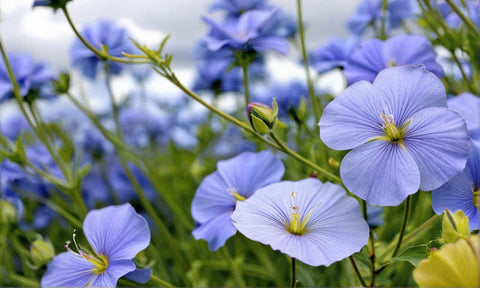
What is linen?
Ah, linen! You may be wondering why so many people are crazy about it. Well, let us enlighten you. Linen is first and foremost a natural plant fiber , a little gem of nature. It is so versatile that it is found almost everywhere, especially in the automotive sector to line the interior of vehicles or to make insulation. It is also found in cutting-edge technology, through cables and conductive wires, or of course (and especially) , in the world of fashion .
Why is it so popular in clothing? It’s simple, it’s literally the perfect summer companion . Lightweight, breathable, and stylish to boot, linen is the perfect fabric for hot summer days. It keeps you cool while giving you that casual chic vibe. So when it comes to feeling comfortable while looking stylish, linen is your best friend.
Origin of Flax
Let us take you back a few (thousands) years to discover the fascinating origin of linen, this fiber that has stood the test of time to become an essential part of our daily lives.
It all started a long time ago, when our ancestors discovered a plant in the Middle East and Asia . They looked at the thin stems and small blue flowers of wild flax, probably wondering what they could do with it.
It was in ancient Egypt that linen really took off . The Egyptians, with their legendary ingenuity, were among the first to cultivate and exploit the possibilities of flax. They called it "ṯnw" or "tenu" and nicknamed it the "cloth of the gods" because of its cultural importance. They quickly realized that the plant could be transformed into fine, strong fibers, perfect for making clothing . The Egyptians used flax to make lightweight, elegant cloths, worn by pharaohs and commoners alike.
Linen was so important in Egypt that the dead were wrapped in linen bandages during mummification, a testament to the high esteem in which this fiber was held. The history of linen was closely intertwined with that of ancient Egypt, and its use extended far beyond the borders of this ancient kingdom.
Over the centuries, flax gained popularity across the world . Its cultivation spread to Europe , where the climate was suitable for its growth.
Today, it is everywhere. From elegant clothing to high-tech textiles and modern composites used in aerospace, linen has evolved with the needs of our society. It remains a symbol of durability, comfort and elegance , while continuing to weave a rich history that goes back thousands of years. Linen is much more than a fiber; it is a precious heritage that has stood the test of time .
If, like the Egyptians, you have a particular attraction to linen, do not hesitate to check out our selection of linen fabrics, 100% from end of series . We are sure that you will find what you are looking for, except perhaps if it is to mummify someone…
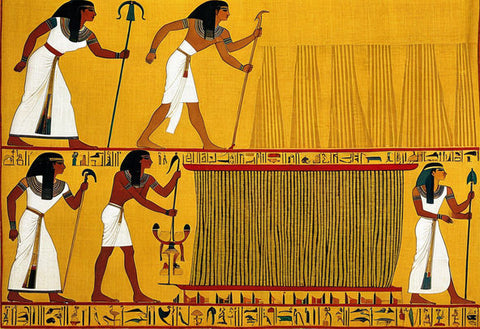
The main producing countries in Europe
Let's discover together the champions of flax cultivation, these countries that make flax one of their agricultural stars. And guess who is at the top of the ranking? Well, it's our beautiful France!
🥇 France: The king of linen
When it comes to flax cultivation, France holds the crown! It is the world’s leading producer of this fascinating plant fibre. As it travels through the beautiful flax fields of Normandy, Picardy and Flanders, France demonstrates its love for this crop . Its mild climate, pleasant summers and moderate winters create an ideal environment for flax . In 2021, France harvested an impressive total of 678,390 tonnes of flax, processed but not spun , from an area of 112,580 ¹ . Each year, France contributes significantly to the world’s supply of flax .
🥈 Belgium: The Flax Race
Right next to France, Belgium is not to be outdone! It occupies an important place in the production of flax, particularly in the regions of Flanders and Wallonia. The Belgian fields are a real patchwork of soft green, producing high-quality flax fibers .
According to the latest information collected, in 2021 Belgium contributed significantly to global flax production by harvesting 87,000 tonnes of flax, processed but not spun , from a harvested area of 15,390 hectares² .
🥉 The Netherlands: The Rising Star
The Netherlands is also a major player in the world of linen. The northern regions of the Netherlands, with their clay soil, are ideal for growing linen. This country, known for its famous windmills, adds a unique touch to the history of linen.
In addition to these three European leaders, other countries like Russia, Ukraine, and China also play a key role in global flax production. Flax is a global business, but Europe is ahead of the curve thanks to its naturally suited climate.🌱
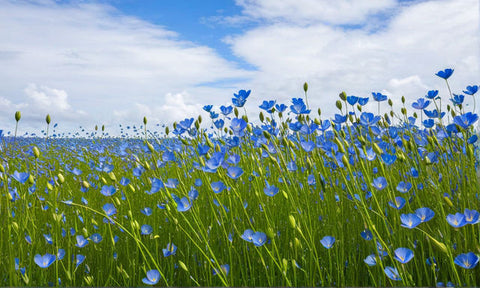
Making Linen Fabric
Let's now review the different stages of making linen fabric, from the field to the finished product.
Step 1: Growing and Harvesting Flax
It all starts, of course, in the fields, where flax is cultivated, growing under the sun and absorbing nutrients from the earth. The ideal climatic conditions for growing flax, with generous sunshine and well-balanced soils , contribute to its optimal development. When the flax reaches maturity, the stalks are delicately pulled from the ground, thus preserving the fibres as much as possible.
Step 2: Scutching
Now that the fibers have been harvested, we will move on to flax scutching, an operation that separates the fibers and straw from the plant . The flax stalks are passed through fluted cylinders, breaking the straw without damaging the fibers. Next, the flax is combed to separate the wood, called " shives ," from the flax fiber. This step is essential to obtain a perfectly pure fiber.
Step 3: Combing
The flax combing phase, the third essential step in its processing, is carried out by gradually scraping the thread using increasingly fine combs . This process eliminates all persistent straw residues , while delicately separating the fibers from each other. The fibers, at the end of this operation, become delicate and blend almost harmoniously, almost reminiscent of the softness of silk. This step leads to the creation of a continuous ribbon, which will then undergo a twist to metamorphose into a fine strand, commonly called " drawing ".
Step 4: Spinning
Now that the combing is complete, it is time to move on to spinning the flax. The producer will have the choice between two methods .
First, wet spinning , where long fibers are combed and then dipped in hot water, making them soft and supple. They are then twisted to create a high-quality yarn, perfect for making clothing .
Then there is dry spinning , where combed and drawn tows are used without soaking. This method produces thicker and stronger yarns, ideal for making technical and decorative fabrics . The choice between wet spinning and dry spinning will therefore depend on the intended application for the linen yarns.
Step 5: Weaving
The final phase of linen processing revolves around weaving on conventional looms . The interlacing of the warp and weft threads, one by one, gives rise to a multitude of linen textiles, whether pure or in combination with other fibres. For example, it is possible to create unique fabrics by combining linen with bamboo fibres for the warp and wool for the weft, thus offering a varied range of textures and properties.
Step 6: Ennobling
After weaving, linen enters a fascinating stage, that of finishing . This phase aims to sublimate the qualities of the fabric by giving it a touch of perfection. Finishing artisans use a set of techniques that can include bleaching, dyeing, finishing, and even embossing . The result is a transformed linen, not only aesthetically dazzling, but also functionally adapted to specific needs, whether elegant clothing, home linens or innovative technical textiles . This step adds an extra dimension to the magic of linen transformation.
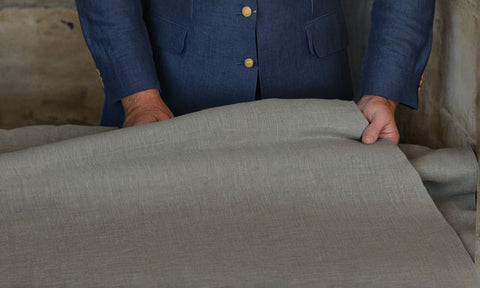
The different types of linen fabrics
Linen is not limited to just one style. There are a multitude of types of linen fabrics to suit every need. Let’s take a closer look.
Fabrics for clothing
Chambray linen : Lightweight and breathable, ideal for summer shirts and light dresses.
Denim Linen : Sturdy and casual, perfect for jeans and durable clothing.
Jersey linen : Stretchy and comfortable, suitable for close-fitting clothing and underwear.
Linen blend : Combined with other fibers such as cotton or hemp, it offers a variety of textures and characteristics.
Upholstery Fabrics
Linen canvas : Durable and textured, ideal for curtains, tablecloths and cushions.
Velvet linen : Luxurious and soft, perfect for sofas and armchairs.
Linear linen : Smooth and elegant, it is suitable for upholstered chairs and cushion covers.
Technical Fabrics
Coated linen : Made waterproof thanks to a protective coating, it is used for rainwear and accessories.
Fireproof linen : Special treatment for fire resistance, it is used in the security industry.
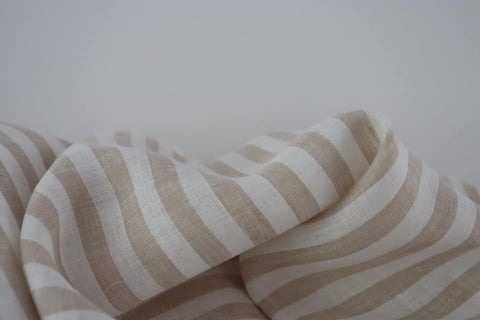
In conclusion, linen is much more than just a fabric . It has a rich history, tradition and incredible versatility. So, the next time you wear your favorite linen shirt, remember all the steps that have gone into making this fabric comfortable and stylish .
Bibliography
- FAOSTAT. (2024). https://data.un.org/. Retrieved from UNdata: https://data.un.org/Data.aspx?d=FAO&f=itemCode%3a773%3bcountryCode%3a68%3byear%3a2021&c=2,4,5,6,7&s=countryName:asc,elementCode:asc,year:desc&v=1
- FAOSTAT. (2024). https://data.un.org/. Retrieved from UNdata: https://data.un.org/Data.aspx?d=FAO&f=itemCode%3a773%3bcountryCode%3a68%3byear%3a2021&c=2,4,5,6,7&s=countryName:asc,elementCode:asc,year:desc&v=1
